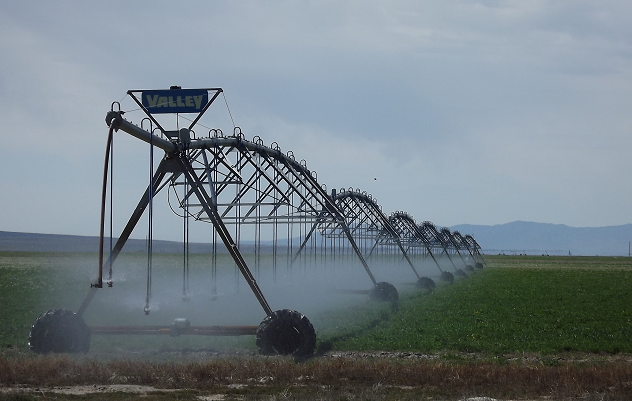 |
A pdf version of this post including end notes is available here.
Once again this summer, all of us in Utah will be urged to “Slow the Flow” and use less water for washing, brushing and flushing. Not a bad idea – but the water we use in and around our homes represents only a small share of the total water use in our state.
A Utah Foundation research report published last year points out that 82% of the developed water resources in Utah are used for agriculture. And half of that is used to irrigate just one crop: alfalfa hay. It consumes more water each year than all the cities and towns in Utah put together.
Hay is big business in Utah. The total value of the alfalfa crop in 2013 was over $425 million. The price of a ton of hay rose from $101 in 2006 to $184 in 2013, thanks in part to new export markets and value-added processing such as hay cubes. Hay represents 15% of the total value of all agricultural production in the state.
The amount of water used to produce that hay varies from farm to farm, depending on elevation, terrain and other factors. But it’s common to use four acre-feet of water in a season to produce three cuttings of alfalfa from one acre of land. It’s a thirsty crop, requiring as much as 75% more water per acre than barley or other spring grains.
Farmers can and do use a number of strategies to reduce that water use, including center-pivot sprinkler systems that can double the efficiency of irrigation and increase yields by as much as 35%. But there’s not much incentive under current Utah law for farmers to conserve.
Water rights – the legal property rights to use water associated with a specific piece of land – are assigned based on “beneficial use.” Farmers who use less water in an efficient operation risk losing their water rights unless they can find another beneficial use for the excess.
Putting more land into cultivation is an option for some, but it requires a change in the allocation that has to be approved by state authorities. Leasing or selling the water rights to other users – including new suburbs sprawling across what was once farm land – is another. But legal rights to the same water are often assigned to multiple users based on the idea of “return flow.” Some of the water is consumed by the plants, but the rest is returned to the hydrologic system such as a river basin. Downstream farmers are still expecting as much as half the water to return to the system through runoff or underground seepage. Any change in the system that reduces return flow trespasses on the rights of downstream users and could trigger a lawsuit. As Utah water rights attorney Jody Williams explains it, the system has to be kept in balance.
 |
Sterling Brown with the Utah Farm Bureau Federation says these are good times for alfalfa farmers, and he expects hay production to be a profitable business going into the future. And it could well be if the price of the water needed to produce that crop stays low. Economist Paul Jakus with Utah State University estimates the current value roughly between $112 and $150 per acre-foot, while the yield per acre using a center-pivot irrigation system is about 5.25 tons. At $184 per ton, that’s $966 – from which, of course, the farmer has to cover other production expenses such as electricity for pumping water, fuel, equipment and labor.
Even in a season of scarcity, the system of water rights that Utah farmers depend on will keep the cost of agricultural water low and keep that thirsty green hay growing, feeding local livestock and serving export markets around the world.
Categories:

